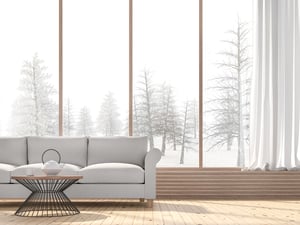Any season can pose a risk of water damage. But winter water damage can catch you by surprise if you don’t take proper precautions.
Water damage in winter is usually caused by frozen pipes that burst. Heavy snowfall can also flood attics and basements. When undetected, it can result in ceiling water damage, mold, or water damage to carpet or hardwood floors.
The severity of water damage is greater when you’re not home to catch it.
Featured Resource:
Winter Water Damage Prevention
Winter water damage most often happens during extreme cold, ice, and snow storms. Prevent damage to your home by following risk mitigation practices:
5 Things to Do for Water Damage Prevention
Install an Automatic Water Shut-Off Valve and Leak Detector
One of the best things you can do is install a smart water shut-off valve. These devices will help detect leaks in your home and shut off the water to prevent damage. Better still, install a battery backup with it in case of a winter storm power outage.
If you’re away from your home often or own more than one home, these can save you a lot of time and headaches. Because even a little water damage can cause mold, leading to extensive remediation and repairs.
Have a Backup Battery-Powered Sump Pump
If your home has a sump pump in the basement or crawl space, make sure to have a battery backup. If bad weather, such as severe thunderstorms or heavy snow, knocks out power, your sump pump can’t prevent flooding.
Having a backup battery-powered sump pump will ensure it still runs and removes water.
Watch for Heavy and Melting Snow
Heavy snow on your roof can potentially cause structural damage. If you have more than six inches of snow on your roof, you’ll need to remove some of the snow to reduce the load.
Likewise, if you have heavy snowfall that starts to melt rapidly, it could leak into your basement. Before winter storms hit, seal up any cracks and crevices in the foundation to prevent leaks. Then, when the storm passes, shovel the snow away from your home's foundation.
Prevent Frozen Pipes from Bursting
If the weather is supposed to be below freezing for extended periods of time, you need to prevent your pipes from freezing. When pipes freeze, the water expands and can damage the pipes. Then, when it thaws, it can burst and flood your home fast.
To prevent this from occurring, follow these three steps:
- Insulate your water pipes.
- Open kitchen and bathroom cabinet doors under the sink to allow warm air near the pipes.
- Turn on faucets to drip overnight to keep water moving and prevent freezing.
If you’re not at home, keep your home at 55 degrees or warmer to prevent pipes from bursting in cold weather. Send someone you trust to take care of the pipes and check on them in the morning. This is also where the automatic shut-off water valve comes in handy.
Stop Ice Dams from Forming
Ice dams form at the edge of the roof, where the roof meets the attic and gutters. The heat from the attic causes the snow to melt into the gutters, where it refreezes and blocks them.
When this happens, the water can leak into your attic and cause damage. To prevent that:
- Insulate your attic to prevent heat from rising to the roof.
- Keep your gutters and downspouts clear so water can easily flow.
- Make sure your attic is well-ventilated to prevent condensation and to allow heat to escape through the vents.
Signs of Damage in Walls, Ceilings and Floors
Here are some warning signs to look out for if you think you may have water damage:
- Paint warping, flaking, or peeling
- Water rings or water stains
- Mold and a musty smell
- Small cracks in the walls or ceiling
- Soft or caving drywall
- Buckling or warped floors
- A dramatic increase in your water bill
How to Prevent Mold After Water Damage
To prevent the need for water damage restoration, you’ll need to take care of any moisture quickly to prevent mold. The best way to prevent mold after water damage is to immediately locate and stop the water leak and dry the area as quickly as possible.
In the case of severe damage, you’ll need professionals to come in and take care of the water damage and mold.
Does Homeowners Insurance Cover Water Damage?
Most standard home insurance policies will cover damage originating from within your home, such as from a burst pipe.
At Vault, we go above and beyond to make sure our customers have peace of mind and immediate attention to their water damage insurance claims – that’s the Vault difference.
When you file a claim, an adjustor will reach out to you within 2 hours and get the information they need to schedule services. On our end, the average time to some form of payment for your claim is 48 hours.
Request a quote and experience the Vault difference for our high-net-worth homes.
Related Products: Homeowners Insurance
Featured Resource:
Winter Water Damage Prevention
Winter water damage most often happens during extreme cold, ice, and snow storms. Prevent damage to your home by following risk mitigation practices:
While Vault believes the information provided in this article to be accurate, we do not warrant the accuracy or reliability of the information provided. Vault is not responsible for, and does not adopt, endorse or approve any third-party webpages, or their content, that may be hyperlinked from this page. Nothing on this page alters any terms or conditions of an insurance policy and is not intended to be taken as legal, medical, or other professional advice.

